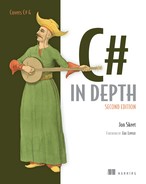Part 3. C# 3: Revolutionizing How We Code
There’s no doubt that C# 2 is a significant improvement over C# 1. The benefits of generics in particular are fundamental to other changes, not just in C# 2 but also in C# 3. But C# 2 is in some sense a piecemeal collection of features. Don’t get me wrong: they fit together nicely enough, but they address a set of individual issues. That was appropriate at that stage of C#’s development, but C# 3 is different.
Almost every feature in C# 3 enables one specific technology: LINQ. Many of the features are useful outside this context, and you certainly shouldn’t confine yourself to only using them when you happen to be writing a query expression, for example—but it’d be equally silly not to recognize the complete picture created by the set of jigsaw puzzle pieces presented in the remaining chapters.
When I originally wrote about C# 3 and LINQ in 2007, I was highly impressed on a somewhat academic level. The more deeply you study the language, the more clearly you see the harmony between the various elements that have been introduced. The elegance of query expressions—and in particular the ability to use the same syntax for both in-process queries and providers like LINQ to SQL—was very appealing. LINQ had a great deal of promise.
Now, two and a half years later, I can look back on the promises and see how they’ve played out. In my experience with the community—particularly on Stack Overflow—it’s obvious that LINQ has been widely adopted and really has changed how we approach many data-oriented tasks. Database providers aren’t just restricted to those from Microsoft—LINQ to NHibernate and SubSonic are just two of the other options available. Microsoft hasn’t stopped innovating around LINQ either: in chapter 12 we’ll see Parallel LINQ and Reactive Extensions, two very different ways of handling data that still use the familiar LINQ operators. And then there’s LINQ to Objects—the simplest, most predictable, almost mundane LINQ provider—and the one that’s most pervasive in industry. The days of writing yet another filtering loop, yet another piece of code to find some maximum value, yet another check to see whether any items in a collection satisfy some condition have gone—and good riddance.
Despite the broad adoption of LINQ, I still see a number of questions which make it clear that some developers regard LINQ as a sort of magic black box. What’s going to happen when I use a query expression, compared with using extension methods directly? When does the data actually get read? How can I make it work more efficiently? Though you can learn a lot of LINQ just by playing with it and looking at examples in blog posts, you’ll get a great deal more out of it by seeing how it all works at a language level, and then learning about what the various libraries do for you.
This is not a book about LINQ—I’m still concentrating on the language features that enable LINQ rather than going into details of concurrency considerations for the Entity Framework and so on. But once you’ve seen the language elements individually and how they fit together, you’ll be in a much better position to learn the details of specific providers.
